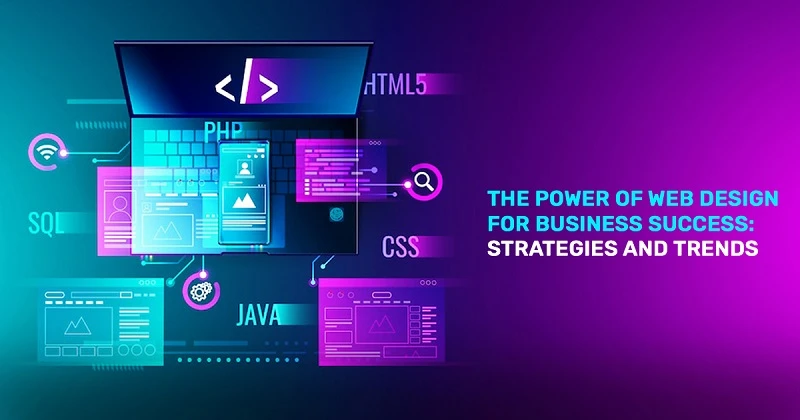Effective Web Design Practices to Optimize Your Site for Conversions
Effective Web Design Practices to Optimize Your Site for Conversions
Blog Article
Elevate Your Online Visibility With Magnificent Internet Design Tips and Trends
The interplay of aesthetic allure, existing layout fads, and customer experience plays a crucial duty in achieving this goal. The subtleties of reliable layout expand past appearances; understanding key techniques for optimization can considerably affect your success.
Significance of Visual Appeal
This statistic emphasizes the essential function that aesthetics play in user involvement and retention. Web design. Efficient aesthetic style encompasses components such as color systems, typography, imagery, and design, all of which add to a enticing and cohesive customer experience.
Furthermore, an aesthetically attractive internet site instills a feeling of reliability and professionalism. Individuals are more probable to rely on a site that looks refined and well-structured, which can considerably influence conversion rates. Conversely, a cluttered or unappealing layout can lead to high bounce rates, as customers might perceive the site as unreliable or out-of-date.
Furthermore, the appearances of a site can convey brand name identification and values. Regular usage of branding elements, such as logos and color combinations, enhances acknowledgment and fosters a deeper connection with the audience. In final thought, focusing on aesthetic allure is important for producing interesting, reliable, and brand-aligned online experiences that resonate with individuals.
Existing Layout Fads
Modern website design is constantly developing, and staying updated with present patterns is vital for producing impactful on-line experiences. One famous fad is the surge of minimalism, identified by tidy lines, adequate white area, and a concentrate on necessary components. This technique not only enhances functionality however additionally enables web content to take spotlight.
Additionally, dark setting user interfaces have gotten popularity, supplying customers with an aesthetically striking option while reducing eye strain. This fad straightens well with customer preferences, supplying a modern-day visual that is both practical and trendy.

In addition, using micro-interactions-- subtle computer animations that engage users-- has actually ended up being integral in enhancing customer experience (Web design). These impactful yet little elements can assist users flawlessly throughout the website
Important Layout Aspects
Effective website design rests on several crucial style elements that with each other create a natural and engaging individual experience. The first of these aspects is format, which dictates just how content is arranged on the web page. A well-structured format not just improves readability however also guides customers through the website seamlessly.
Shade plays an essential function in layout, influencing emotions and brand name perception - Web design. An unified color combination can stimulate specific feelings and develop a visual pecking order, therefore drawing attention to essential aspects. Typography is important; the option of typefaces must align with the brand identification and make certain legibility across gadgets.
In addition, whitespace is frequently ignored yet is crucial for creating equilibrium. It aids stop mess, enabling individuals to focus on the crucial aspects without diversion.
Finally, consistency across all design components enhances brand name identity and makes navigation user-friendly. By diligently incorporating these vital layout elements, web developers can produce functional and aesthetically enticing web sites that mesmerize visitors and urge communication.
Individual Experience Optimization
A seamless customer experience is critical for preserving site visitors and driving conversions on a site. Optimizing customer experience (UX) entails comprehending your audience and customizing design elements to fulfill their requirements effectively. Trick elements of UX optimization consist of user-friendly navigation, quickly packing times, and clear phone call to activity.
Integrate breadcrumb tracks to assist users quickly backtrack, lessening aggravation. Rate is an additional vital variable; websites ought to fill within 3 seconds to avoid customers from deserting the site.
Additionally, your internet site's design ought to prioritize clearness. Usage legible font styles, contrasting colors, and whitespace to develop an aesthetically appealing layout that guides individuals with web content effortlessly. Contact us to activity check this site out must be plainly presented, using actionable language that encourages individuals to involve.
Mobile Responsiveness Methods
Virtually fifty percent of all internet traffic currently stems from mobile phones, highlighting the significance of applying robust mobile responsiveness methods. To ensure optimal individual experience across different screen sizes, web designers should accept a fluid grid design that adapts perfectly to various gadgets. This technique enables material to resize and rearrange without jeopardizing performance or appearances.
Integrating flexible images and media queries is important. Images should automatically readjust their dimension according to Discover More the viewport, while media inquiries can discover device characteristics and apply customized CSS designs appropriately. This technique enhances lots times and makes sure that individuals have a visually appealing experience.
In addition, focus on touch-friendly navigation elements. Buttons and web links must be quickly tappable, with adequate spacing Recommended Reading to protect against misclicks. Staying clear of hover-dependent interactions further boosts usability on touchscreens.
Lastly, conducting normal testing throughout different devices and browsers is critical. Tools like Google's Mobile-Friendly Test can help recognize areas needing improvement. By taking on these mobile responsiveness approaches, companies can improve user engagement, increase internet search engine rankings, and inevitably drive conversions, consequently elevating their on-line visibility successfully.

Verdict
In conclusion, the execution of efficient website design strategies substantially improves online existence. By prioritizing visual charm through existing layout fads and essential components, businesses can foster integrity and interaction. Maximizing customer experience and making certain mobile responsiveness are critical for promoting seamless communication throughout gadgets. As the electronic landscape evolves, accepting these principles will certainly not just mesmerize visitors yet likewise drive conversions, eventually contributing to the total success of on the internet undertakings.

Conversely, a unsightly or chaotic layout can lead to high bounce rates, as customers may view the internet site as untrustworthy or out-of-date.
Reliable web style pivots on several vital design components that with each other create a engaging and cohesive user experience. Optimizing individual experience (UX) involves comprehending your audience and tailoring style components to satisfy their demands properly.
Report this page